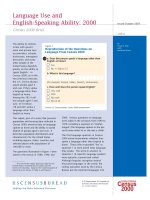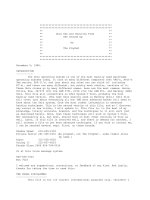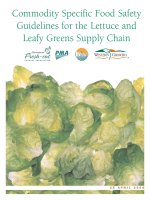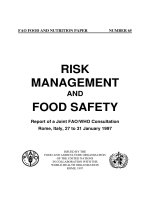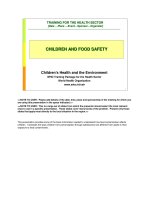Food safety 101 cleaning, sanitation, equipement use and care
Bạn đang xem bản rút gọn của tài liệu. Xem và tải ngay bản đầy đủ của tài liệu tại đây (825.77 KB, 40 trang )
Food Safety 101: Cleaning, Sanitation, Equipment
Use and Care
Level One Certification Course: Area 2
Kentucky Department of Education, Division of School and Community Nutrition
20140630
At the end of this presentation, you will be able
to…
-
Understand and utilize proper cleaning and
sanitation methods;
-
Understand equipment use and care of various
pieces of food service equipment.
20140630
Let’s Look at Cleaning and Sanitation
What is the difference between cleaning and sanitizing?
Cleaning removes the visible soil and food particles
from a surface.
20140630
Sanitizing reduces the number of microorganisms
(bacteria, viruses, etc.)
Just because…
Something that looks clean does not mean it is sanitary. Billions of microorganisms may be present even
though they are not visible to the naked eye.
Both cleaning and sanitizing are essential in preventing foodborne illness.
20140630
When should I clean and sanitize materials?
∗
∗
∗
20140630
Each time there is a change from working with raw
foods to working with ready-to-eat foods.
Between uses with raw fruits and vegetables and
with potentially hazardous foods.
Before using or storing food thermometers (after
each use).
∗
∗
Any time contamination may have occurred.
Before each use with different types of raw animal
food, except in contact with a succession of
different raw animal foods, in which the second
food requires a higher cooking temperature than
the first food.
When should I clean and sanitize surfaces and equipment that contacts potentially hazardous
foods?
At least every 4 hours.
Exceptions:
- Storage containers of potentially hazardous foods should be
cleaned when emptied.
-
At least every 24 hours for containers in serving situations such
as salad bars.
20140630
When should I clean and sanitize surfaces and equipment that contacts non-potentially
hazardous foods?
∗
∗
∗
20140630
You should clean surfaces and equipment at least every 24 hours or any time
contamination may occur.
Also, before restocking consumer self-service equipment and utensils such as condiment
dispensers.
Also clean enclosed components of equipment such as ice bins, ice makers, beverage
nozzles & syrup dispenser tubes, cooking oil storage tanks & distribution lines, coffee
bean grinders, and water vending equipment, as specified by the manufacturer or as
necessary to preclude accumulation of soil or mud.
Be careful…
∗
20140630
Make sure that you can’t contaminate food during and with the use of cleaners and
sanitizers.
Proper Chemical/Cleaning Storage
∗
∗
∗
∗
20140630
Always store chemicals safely away from all food.
Keep chemicals safely secured at all times.
Keep chemicals in their original container.
Store chemicals according to the directions on the label.
Chemical Usage:
∗
∗
∗
∗
∗
∗
20140630
Don’t use chemical if you haven’t properly been trained.
Always put food and packaging away before chemical usage.
Use only approved chemicals for the task you are doing.
Use only according to the manufacturer label.
Always make sure there is a proper label attached to the container.
Know where to locate the Material Safety Data Sheets (MSDS) for all chemicals.
Let’s look at:
Cleaning and Sanitizing Using a 3 Compartment Sink.
There are five steps to correctly utilize a 3 compartment sink.
20140630
3 Compartment Sink Process
Step 1: Pre-scrape
-
Rinse, scrape, or soak all items before washing.
Have a waste receptacle near the 3 compartment sink if necessary.
Step 2: Wash
- Wash in hot water, at least 110° F, with detergent.
20140630
3 Compartment Sink Process
Step 3: Rinse
Rinse off soap residue using clear, warm water.
Step 4: Sanitize
Sanitize in warm water, at least 75° F*, with:
-
50 ppm chlorine, immersed for 1 minute;
or
-
12.5 ppm iodine, immersed for 1 minute;
or
-
200 ppm QAC, immersed for 1 minute.
*Sanitizing instructions differ per product, be sure to
20140630
check the manufacturer’s directions.
Key Tip to Sanitizing!
It is important to monitor the sanitizing solution
to ensure the correct amount is added to the
water:
- too much sanitizer is toxic.
- too little is unsanitary.
Use test strips to monitor the pH of your sanitizer solution.
20140630
3 Compartment Sink Process
Step 5: Air Dry
Air dry all equipment and utensils before stacking to eliminate the growth of microbes.
20140630
Let’s look at:
Dish Machine Washing and Sanitizing
There are two kinds of commercial dish machines: chemical sanitizing
machines and hot-water sanitizing machines.
Chemical Sanitizing
These machines use chlorine-based chemicals dispensed during
the final rinse to sanitize equipment. The chemical level should be 50
ppm in the final rinse water. As with manual dish washing, sanitizer
strength should be monitored using test-strips.
Hot Water Sanitizing
These machines use very hot water during the final rinse to
sanitize equipment. This water should be 180° F to effectively
sanitize. Often times a Booster Heater is used to
achieve proper water temperature.
20140630
Dish machines should be monitored for:
-
food debris and grease residue.
proper soap amount dispensed during
wash cycle.
-
20140630
sanitizer strength (chemical, sanitizing only).
wash and final rinse temperatures.
Let’s look at:
Wiping Cloths
∗
∗
Cloths used for wiping food spills should
be used for no other purposes.
Cloths used for wiping food spills shall
be:
∗
∗
∗
20140630
Dry and used on tableware and carryout containers; If using a dry towel
sanitize also if necessary, OR
Wet and clean, stored in a chemical
sanitizer, and used on food and
nonfood contact equipment.
Change sanitizing solution frequently.
∗
∗
Keep dry or wet cloths used with raw
animal products separate, including
having a separate sanitizing solution.
Dry and wet cloths used with fresh
sanitizing solution shall be free of food
debris and visible soil.
Equipment Use and Care
20140630
Knives
−
−
20140630
Basic Knife Safety
Carry a knife by the handle with the
tip down and the blade turned
away from your body.
Place a damp cloth under the
cutting board to prevent it from
sliding.
The Chef’s Knife
∗
20140630
/>27s%20Knife&number=&keywords=&from=&to=&category=&subject=0&audienc
e=0&course=0&media=5&language=0
A few more tips on Knife Safety
∗
∗
∗
∗
∗
∗
∗
20140630
When using a knife, concentrate on the task at hand.
Use different colored chopping boards for different food items to prevent cross-contamination.
Always use sharp knives that are the correct size and blade type for the job.
Do not hold food in your hand while you cut.
Keep handles free of grease and other slippery substances.
Wash knives immediately after use.
Store knives in a knife rack or in a dedicated knife drawer with blade covers.
Care of Knives
∗
∗
∗
∗
∗
20140630
Wash thoroughly after each use in hot water and a mild soap or dish detergent and dry thoroughly with a clean
towel.
When washing knives in a 3 compartment sink, leave knife on the pre-scrape area for safety. Do not leave
soaking in water out of sight.
When drying a knife, do not leave the knife’s edge in a manner that can be harmful.
For plated knives, clean carefully to ensure platting is not scratched or worn off.
Never allow a wooden handled knife to soak in water.
How do I use and take care of a
Food Mixer?
∗
20140630
A food mixer is used to blend and combine foods.
They use attachments such as beaters, whips,
slicers, graters, shredders, choppers and knives
to make changes to the specific use of the
machine.
Helpful Operating Tips for a Food Mixer
∗
∗
∗
∗
20140630
Select the proper bowl and attachment for the mixture.
Always use scrapers or spoons to scrape down bowl and remove food from beater.
Allow proper mixing time for products- over mixing is as damaging as under mixing.
Put a piece of bread through the chopper after grinding cheese.




